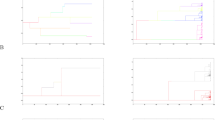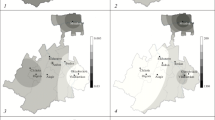Abstract
Reproductive processes within the current Ugandan epidemic of sleeping sickness are investigated. Genotype frequencies derived from isoenzyme patterns in 44 stocks ofTrypanosoma brucei s.l. collected in 1988 from Tororo, south-east Uganda are analysed by single and multiple loci methods. In the single locus method, the hypothesis of random mating is tested by agreement with Hardy-Weinberg equilibrium. The multiple loci method uses a contingency table approach to detect nonrandom associations between pairs of loci; this equates to the detection of disequilibrium. The results do not support the concept of a randomly mating population ofT. brucei within the current epidemic. Results from the epidemic data set are discussed in relation to the broader problem of genetic exchange inTrypanozoon.
Similar content being viewed by others
References
Baker JR (1977) Sex in trypanosome life cycles. Trans R Soc Trop Med Hyg 72:109–112
Cibulskis RE (1988) Origins and organization of genetic diversity in natural populations ofTrypanosoma brucei. Parasitology 96:303–322
Cibulskis RE (1992) Genetic variation inTrypanosoma brucei and the epidemiology of sleeping sickness in the Lambwe Valley, Kenya. Parasitology 104:99–109
Clarke CA (1977) Human genetics and medicine. Studies in Biology, no. 20. Arnold, London
Elston RC, Forthofer R (1977) Testing for Hardy-Weinberg equilibrium in small samples. Biometrics 33:536–542
Fairburn DJ, Roff DA (1980) Testing genetic models of isoenzyme variability without breeding data: Can we depend on the χ2? Can J Fish Aquat Sci 37:1149–1159
Fisher RA (1934) Statistical methods for research workers, 5th edn. Oliver and Boyd, Edinburgh
Ford J (1979) Ideas which have influenced attempts to solve the problem of African trypanosomiasis. Sociol Sci Med 30[B]:269–275
Gibson W (1990) Trypanosome diversity in Lambwe Valley, Kenya — sex or selection? Parsitol Today 6:342–343
Gibson WC (1989) Analysis of a genetic cross betweenTrypanosoma brucei rhodesiense andT. b. brucei. Parasitology 99:391–402
Gibson WC, Gashumba JK (1983) Isoenzyme characterization of someTrypanozoon stocks from a recent trypanosomiasis epidemic in Uganda. Trans R Soc Trop Med Hyg 77:114–118
Gibson WC, Wellde BT (1985) Characterization ofTrypanozoon stocks from the South Nyanza sleeping sickness focus in Western Kenya. Trans R Soc Trop Med Hyg 79:671–676
Gibson WC, Marshall RF de C, Godfrey DG (1980) Numerical analysis of enzyme polymorphism: a new approach to the epidemiology of trypanosomes of the subgenusTrypanozoon. Adv Parasitol 18:175–246
Gibson WC, Osinga KA, Michels PAM, Borst P (1985) Trypanosomes of subgenusTrypanozoon are diploid for housekeeping genes. Mol Biochem Parasitol 16:231–242
Godfrey DG, Baker RD, Rickman LR, Mehlitz D (1990) The distribution, relationships and identification of enzymic variants within the subgenusTrypanozoon Adv Parasitol 29:1–74
Haldane JBS (1954) An exact test for randomness of mating. J Genet 52:631–635
Hebert PDN, Crease T (1983) Clonal diversity in populations ofDapnia pulex reproducing by obligate parthenogenesis. Heredity 51:353–369
Hide G, Buchanan N, Welburn S, Maudlin I, Barry JD, Tait A (1991)Trypanosoma brucei rhodesiense: characterisation of stocks from Zambia, Kenya and Uganda using repetitive DNA probes. Exp Parasitol 72:430–439
Jenni L, Marti S, Schweizer J, Betschart B, Lepage RWF, Wells JM, Tait A, Paindavoine P, Pays E, Steinert M (1986) Hybrid formation between African trypanosomes during cyclical transmission. Nature 322:173–175
Maudlin I, Welburn SC, Gashumba JK, Okuna N, Kalunda M (1990) The rôle of cattle in the epidemiology of sleeping sickness in Uganda. In: Proceedings of the VII International Congress of Parasitology. Paris, Bulletin de la Société Française de Parasitologie Vol 8 pp 788 [Suppl 2]
Mbulamberi DB (1989) Possible causes leading to an epidemic outbreak of sleeping sickness. Facts and hypotheses. Ann Soc Belg Med Trop 69:173–179
Mihok S, Otieno LH, Darji N (1990) Population genetics ofTrypanosoma brucei and the epidemiology of human sleeping sickness in the Lambwe Valley, Kenya. Parasitology 100:219–233
Okoth JO, Kapaata R (1986) Trypanosome infection rates inGlossina fuscipes fuscipes Newst. in the Busoga sleeping sickness focus, Uganda. Ann Trop Med Parasitol 80:459–461
Reed TE (1968) Distributions and tests of independence of seven blood group systems in a large multiracial sample from California. Am J Hum Genet 20:142–150
Sokal RR, Rohlf FJ (1981) Biometry, 2nd edn. Freeman, New York
Steel RGD, Torrie JH (1981) Prinicples and procedures of statistics, 2nd edn. McGraw-Hill, Singapore
Sternberg J, Tait A, Haley S, Wells JM, LePage RWF, Schweizer J, Jenni L (1988) Gene exchange in African trypanosomes: characterization of a new hybrid genotype. Mol Biochem Parasitol 27:191–200
Stevens JR, Godfrey DG (1992) Numerical taxonomy ofTrypanozoon based on polymorphisms in a reduced range of enzymes. Parasitology 104:75–86
Stevens JR, Lanham SM, Allingham R, Gashumba JK (1992) A simplified method for identifying subspecies and strain groups inTrypanozoon by isoenzymes. Ann Trop Med Parasitol 86:9–28
Suomalainen E, Saura A, Lokki J (1976) Evolution of parthenogenic insects. Evol Biol 9:209–267
Tait A (1980) Evidence for diploidy and mating in trypanosomes. Nature 287:536–538
Tait A (1983) Sexual processes in Kinetoplastida. Parasitology 86:29–57
Tait A, Barry JD, Wink R, Sanderson A, Crowe JS (1985) Enzyme variation inTrypanosoma brucei spp. II. Evidence forT. b. rhodesiense being a set of variants ofT. b. brucei. Parasitology 90:89–100
Tait A, Turner CMR, Le Page RWF, Wells J (1989) Genetic evidence that metacyclic forms ofTrypanosoma brucei are diploid. Mol Biochem Parasitol 73:247–256
Tibayrenc M, Cariou ML, Solignac M (1981) Interprétation génétique des zymogrammes de Flagellés des genresTrypanosoma etLeishmania. C R Acad Sci [D] Paris 292:623–625
Tibayrenc M, Kjellberg F, Ayala FJ (1990) A clonal theory of parasitic protozoa: The population structures ofEntamoeba, Giardia, Leishmania, Naegleria, Plasmodium, Trichomonas, andTrypanosoma and their medical and taxonomical consequences. Proc Natl Acad Sci USA 87:2414–2418
Tibayrenc M, Kjellberg F, Arnaud J, Oury B, Brenière SF, Darde M-L, Ayala FJ (1991) Are eukaryotic microorganisms clonal or sexual? A population genetics vantage. Proc Natl Acad Sci USA 88:5129–5133
Workman PL (1969) The analysis of simple genetic polymorphisms. Hum Biol 41:97–114
Author information
Authors and Affiliations
Rights and permissions
About this article
Cite this article
Stevens, J.R., Welburn, S.C. Genetic processes within an epidemic of sleeping sickness in Uganda. Parasitol Res 79, 421–427 (1993). https://doi.org/10.1007/BF00931833
Received:
Accepted:
Issue Date:
DOI: https://doi.org/10.1007/BF00931833




